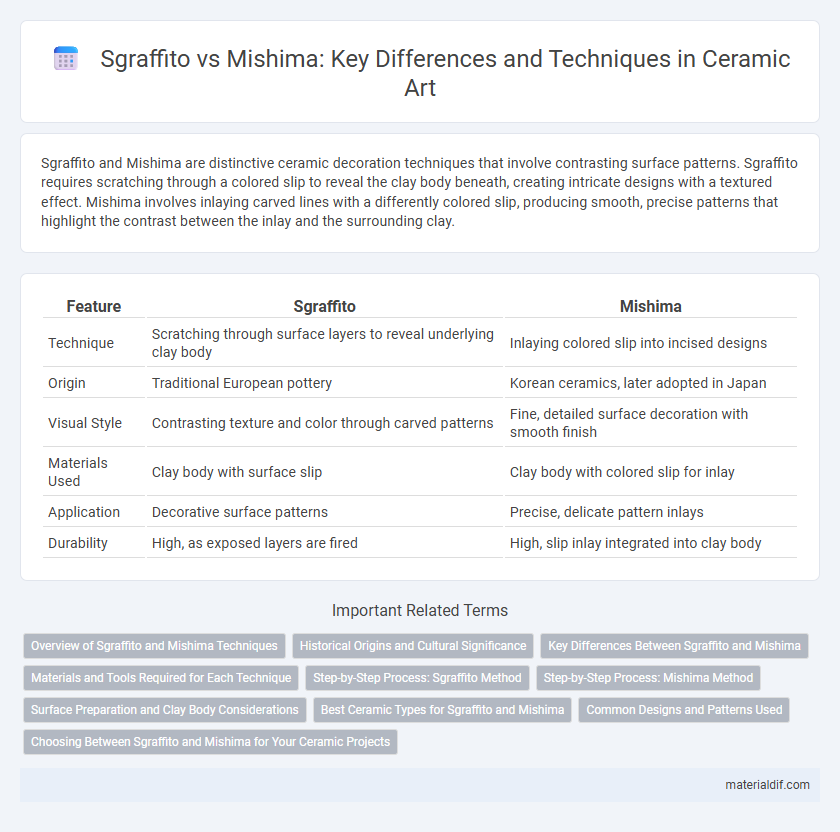Sgraffito and Mishima are distinctive ceramic decoration techniques that involve contrasting surface patterns. Sgraffito requires scratching through a colored slip to reveal the clay body beneath, creating intricate designs with a textured effect. Mishima involves inlaying carved lines with a differently colored slip, producing smooth, precise patterns that highlight the contrast between the inlay and the surrounding clay.
Table of Comparison
| Feature | Sgraffito | Mishima |
|---|---|---|
| Technique | Scratching through surface layers to reveal underlying clay body | Inlaying colored slip into incised designs |
| Origin | Traditional European pottery | Korean ceramics, later adopted in Japan |
| Visual Style | Contrasting texture and color through carved patterns | Fine, detailed surface decoration with smooth finish |
| Materials Used | Clay body with surface slip | Clay body with colored slip for inlay |
| Application | Decorative surface patterns | Precise, delicate pattern inlays |
| Durability | High, as exposed layers are fired | High, slip inlay integrated into clay body |
Overview of Sgraffito and Mishima Techniques
Sgraffito and Mishima are traditional ceramic decoration techniques that create distinct surface designs by manipulating contrasting layers of clay or slip. Sgraffito involves scratching through a surface layer to reveal a different color beneath, producing intricate, textured patterns. Mishima, also called inlay, consists of carving fine lines into the clay and filling these incised lines with colored slip for a smooth, detailed contrast.
Historical Origins and Cultural Significance
Sgraffito, originating from the Renaissance period in Europe, involves scratching through a surface layer to reveal a contrasting color beneath, serving both decorative and narrative purposes in ceramics. Mishima, with roots in ancient Korean Gaya and Japanese ceramic traditions, features inlaid slip designs that highlight cultural symbolism and craftsmanship precision. These techniques reflect distinct historical trajectories and embody significant cultural expressions within their respective regions.
Key Differences Between Sgraffito and Mishima
Sgraffito involves scratching through a surface layer of slip or glaze to reveal the clay body underneath, creating contrasting designs with texture and depth. Mishima, also known as inlay technique, requires incising patterns into the clay and then filling the incisions with colored slip, producing smooth, crisply defined motifs. Key differences include sgraffito's subtractive method versus mishima's additive-inlay process and the visual effect of textured relief compared to flush, embedded decoration.
Materials and Tools Required for Each Technique
Sgraffito technique requires a leather-hard clay body coated with a layer of contrasting slip, along with sharp tools like needles, knives, or styluses to scratch away the surface and reveal underlying clay. Mishima involves incising designs into the clay body and filling the grooves with a contrasting colored slip or inlay, typically using fine-pointed tools such as carving needles and brushes for precise slip application. Both techniques rely on slips compatible with the clay body and require careful control of slip thickness and drying times to achieve clean, sharp detailing.
Step-by-Step Process: Sgraffito Method
The Sgraffito method in ceramics involves applying a layer of colored slip or underglaze onto the leather-hard clay surface, followed by carefully scratching through this layer using a sharp tool to reveal the contrasting clay body beneath. This step-by-step process requires precision to create intricate designs or patterns, often emphasizing line work and texture variations. After etching, the piece is dried, bisque fired, glazed, and finally glaze fired to enhance the visual contrast and durability of the sgraffito decoration.
Step-by-Step Process: Mishima Method
The Mishima method involves carving fine lines or patterns into the pottery surface, then filling these incised designs with colored slip before allowing it to dry. After the slip sets, the excess is carefully scraped away, revealing the intricate inlaid decoration contrasting with the clay body beneath. This technique requires precision in both incising and slip application to achieve clean, crisp patterns characteristic of Mishima ceramics.
Surface Preparation and Clay Body Considerations
Sgraffito requires a smooth, leather-hard surface to precisely carve through colored slip, often favoring fine-grained stoneware or porcelain clay bodies for clean lines. Mishima involves inlaying slip into incised patterns, benefiting from a firm, well-leveled leather-hard clay body that allows for sharp, deep incisions without cracking. Both techniques demand controlled moisture content and consistent hardness to ensure slip adhesion and prevent surface distortion during firing.
Best Ceramic Types for Sgraffito and Mishima
Porcelain and stoneware are the best ceramic types for sgraffito due to their smooth surfaces and durability, which allow precise incisions and vivid contrast between layers. Mishima techniques benefit from fine-grained stoneware, as its consistent texture holds inlaid slip effectively for intricate patterns without blurring. Both methods require ceramics that tolerate multiple firings and maintain crisp detail after glazing.
Common Designs and Patterns Used
Sgraffito and Mishima are traditional ceramic decoration techniques distinguished by their design styles and patterns. Sgraffito involves scratching through a surface layer to reveal a contrasting color beneath, creating intricate, linear, and often floral or geometric patterns. Mishima employs inlaying colored slip into incised lines, producing delicate, precise motifs such as dots, waves, and stylized nature-inspired designs common in Korean and Japanese pottery.
Choosing Between Sgraffito and Mishima for Your Ceramic Projects
Choosing between Sgraffito and Mishima techniques depends on the desired aesthetic and texture for your ceramic projects. Sgraffito involves scratching through a surface layer to reveal a contrasting color beneath, ideal for bold, graphic designs, while Mishima features inlaying slip into incised lines, offering delicate, intricate patterns. Consider the complexity of your design and the required precision, as Mishima demands careful filling and scraping, whereas Sgraffito allows for more spontaneous, expressive marks.
Sgraffito vs Mishima Infographic

 materialdif.com
materialdif.com